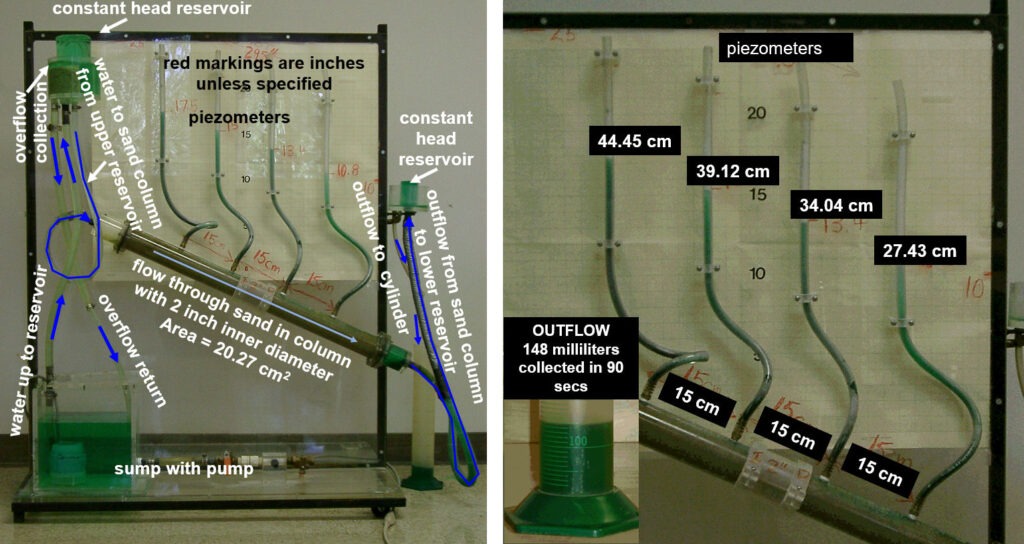
hydraulic conductivity.jpg

Hydraulic Conductivity
Definition:
Hydraulic conductivity, also known as permeability, refers to the ability of soil or other porous media to transmit water under hydraulic gradient conditions. It is a crucial parameter influencing water movement, infiltration, and drainage within the soil profile, thereby impacting plant growth, groundwater recharge, and surface runoff.
Factors Influencing Hydraulic Conductivity:
- Soil Texture: The particle size distribution of soil particles significantly influences hydraulic conductivity. Coarse-textured soils such as sand exhibit higher conductivity due to larger pore spaces, facilitating rapid water movement. In contrast, fine-textured soils like clay have smaller pores, resulting in lower conductivity and increased water retention.Evidence: Research published in the Soil Science Society of America Journal confirms that soil texture strongly correlates with hydraulic conductivity, with sandy soils demonstrating greater permeability compared to clayey soils.
- Soil Structure: Soil aggregation and pore geometry influence hydraulic conductivity by affecting pore continuity and tortuosity. Well-aggregated soils with stable macroaggregates enhance water infiltration and conductivity, whereas compacted or structureless soils restrict water movement and decrease conductivity.Evidence: A study conducted by the Agricultural Research Service (ARS) highlights the importance of soil structure in regulating hydraulic properties and suggests management practices such as reduced tillage to improve soil structure and enhance conductivity.
- Soil Moisture Content: Hydraulic conductivity varies with soil moisture status, exhibiting nonlinear behavior under different moisture regimes. At low moisture levels, conductivity may decrease due to increased soil water tension and reduced pore connectivity. Conversely, saturated conditions can lead to reduced conductivity due to pore clogging and waterlogging.Evidence: Research from the International Journal of Environmental Research and Public Health elucidates the complex relationship between soil moisture content and hydraulic conductivity, emphasizing the need for dynamic modeling approaches to assess water movement in soil profiles.
Applications in Agriculture:
- Irrigation Management: Understanding soil hydraulic conductivity is essential for optimizing irrigation practices and ensuring efficient water use in agriculture. Knowledge of soil permeability helps farmers determine irrigation scheduling, application rates, and distribution uniformity to meet crop water requirements effectively.Evidence: According to a study published in the Journal of Irrigation and Drainage Engineering, incorporating soil hydraulic properties into irrigation scheduling models improves water use efficiency and crop productivity, leading to significant water savings and economic benefits.
- Drainage Design: Proper drainage is critical for mitigating waterlogging and soil salinity problems in agricultural lands. Assessing soil hydraulic conductivity enables engineers to design effective drainage systems that promote excess water removal and prevent crop damage.Evidence: Research conducted by the United States Department of Agriculture (USDA) emphasizes the importance of site-specific characterization of soil hydraulic properties for designing efficient agricultural drainage systems, minimizing environmental impacts and maximizing land productivity.
- Soil Management: Managing soil properties such as organic matter content, compaction, and tillage practices can influence hydraulic conductivity and overall soil health. Implementing soil conservation measures and soil amendments enhances soil structure, porosity, and water infiltration rates, improving crop productivity and sustainability.Evidence: A meta-analysis published in the European Journal of Soil Science highlights the positive effects of soil management practices on soil hydraulic properties, emphasizing the role of sustainable agriculture in enhancing soil water dynamics and ecosystem resilience.
Future Perspectives:
- Advancements in Modeling: Integrating soil hydraulic conductivity data into predictive models and decision support tools enhances precision agriculture practices and climate change adaptation strategies, enabling farmers to optimize resource use and mitigate risks associated with water scarcity and extreme weather events.
- Technological Innovations: Emerging technologies such as remote sensing, proximal sensing, and soil sensors offer opportunities for real-time monitoring and characterization of soil hydraulic properties, facilitating data-driven management decisions and enhancing agricultural resilience.
- Interdisciplinary Collaboration: Collaboration between soil scientists, agronomists, engineers, and policymakers is essential for addressing complex challenges related to soil-water interactions and promoting sustainable land management practices that balance agricultural productivity with environmental conservation and resilience.
In conclusion, hydraulic conductivity plays a critical role in regulating water movement and availability in agricultural soils, influencing crop growth, water resource management, and ecosystem sustainability. By understanding the factors affecting conductivity and adopting evidence-based management practices, farmers can optimize water use efficiency, mitigate risks, and promote agricultural resilience in a changing climate.
Fall off the barn roof and busted your keister? Life on the farm or ranch can be tough on the bum. Need a break? Laugh it off at FarmerCowboy.com, the #1 farm humor site. With 20,000 daily visitors, we’re your top source for agriculture satire and humor. Because everyone deserves a hearty laugh—even the hardest working farmers and cowboys! Join us and turn those long days into fun tales at FarmerCowboy.com.
Originally posted 2020-11-07 21:41:10.
Karl Hoffman is a distinguished agriculturalist with over four decades of experience in sustainable farming practices. He holds a Ph.D. in Agronomy from Cornell University and has made significant contributions as a professor at Iowa State University. Hoffman’s groundbreaking research on integrated pest management and soil health has revolutionized modern agriculture. As a respected farm journalist, his column “Field Notes with Karl Hoffman” and his blog “The Modern Farmer” provide insightful, practical advice to a global audience. Hoffman’s work with the USDA and the United Nations FAO has enhanced food security worldwide. His awards include the USDA’s Distinguished Service Award and the World Food Prize, reflecting his profound impact on agriculture and sustainability.



